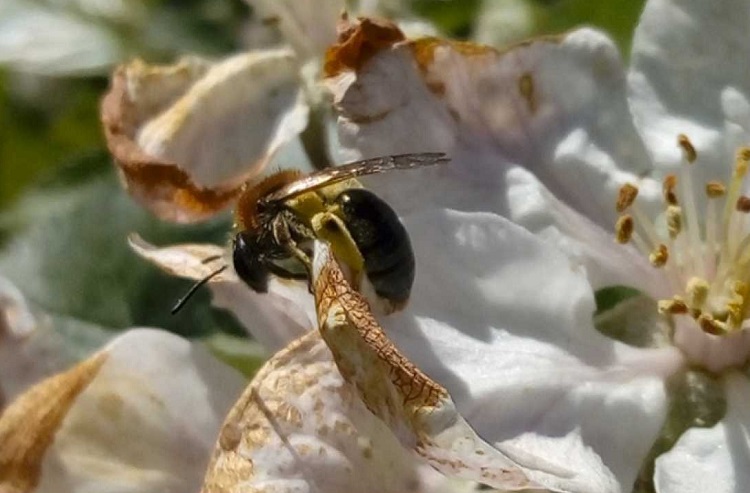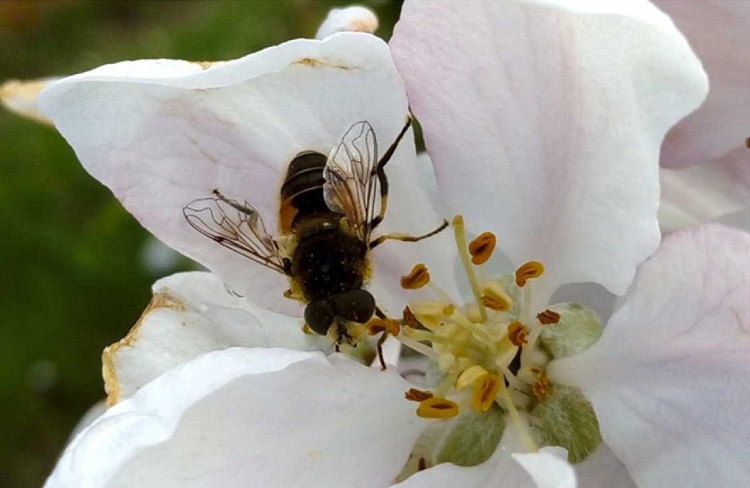Healthy bee population is financial boon for Ireland's apple growers, suggests UCD research
Posted 8 March, 2022

A healthy bee population would represent a financial boon for Ireland's apple growers suggests new UCD research.
It is well documented that bees, and other insect pollinators such as wasps and hoverflies, are vital in the pollination of several Irish crops, and (opens in a new window)a new study from the UCD School of Agriculture and Food Science puts this in focus – showcasing that insect pollination contributes to 93% of the market value of domestic dessert apples sold in Ireland, and 46% of the market value for apples used in Irish cider production.
This economic activity accounts for over €800,000 per year added value to combined apple production in Ireland, and according to Dr Dara Anne Stanley, Irish apple producers could see even greater benefits with more successful pollination from wild and managed bees.
“We found that yield of desert apples was limited by the amount of pollination they received. So more pollination by insect pollinators could increase harvests of this crop in Ireland,” said the reseacher from the UCD School of Agriculture and Food Science.
While all pollinators – including flies and bees – contributed to apple pollination, honeybees and bumblebees were found to be the most important pollinators of Jonagored (dessert) apples, while honeybees contribute the most to Dabinett (cider apples) pollination.
Of note, the study - by lead author UCD PhD candidate Katherine Burns and Dr Stanley, stresses the importance of wild insect diversity and suggests that the agricultural sector in Ireland be encouraged to promote general insect pollinator biodiversity to maintain and increase the stability of pollination services over time.

Hoverflies, known as flower flies, and solitary bees could make good targets for future pollinator management across Ireland, the research suggests, Credit: Katherine Burns, PhD candidate in the UCD School of Agriculture & Food Science
Honeybee visitation rates varied considerably between apple cultivars, the University College Dublin researchers found – noting the need for a more comprehensive understanding of crop pollination requirements depending on the region
They suggest that hoverflies, known as flower flies, and solitary bees could make good targets for future pollinator management across Ireland as hoverflies exhibited high floral visitation rates, and solitary bees were found to transport large amounts of pollen during their travels.
So excited to announce that my (opens in a new window)#PhD research on the contributions of insect (opens in a new window)#pollinators to apple production has been published in Agriculture, Ecosystems, and Environment!
— Katherine Burns (@kburns_buzz) (opens in a new window)February 19, 2022
Check out this thread to learn more about our results! (or better yet, read the paper!) (opens in a new window)https://t.co/OpljUWaThq
Although their economic value to apples is currently much smaller than honeybees, the UCD researchers stressed that the activity of wild bees and hoverflies was significant – in helping to improve the quality and quantity of a harvest at little to no cost, with some species of flower flies also providing pest control by eating other common insects such as aphids.
“While we already have populations of wild insects on farmland in Ireland providing pollination to crops, we also know that pollinators are declining. Pollinator numbers can be increased and stabilised on farmland by providing more habitat through simple measures such as planting new hedgerows, letting existing hedges and field margins flower, or reducing or eliminating use of pesticide,” said Dr Stanley.
By: David Kearns, Digital Journalist / Media Officer, UCD University Relations
Latest
- Taoiseach announces State Funding for student accommodation with proportion held at discounted rents for students most in need
- Speaker Emerita Nancy Pelosi receives honorary degree for lasting legacy to public service
- Video series to build AI policy capabilities among leaders launched by UCD Centre for Digital Policy
UCD academics on The Conversation
- Opinion: The leap year is February 29, not December 32 due to a Roman calendar quirk – and fastidious medieval monks
- Opinion: Nigeria’s ban on alcohol sold in small sachets will help tackle underage drinking
- Opinion: Nostalgia in politics - Pan-European study sheds light on how (and why) parties appeal to the past in their election campaigns






